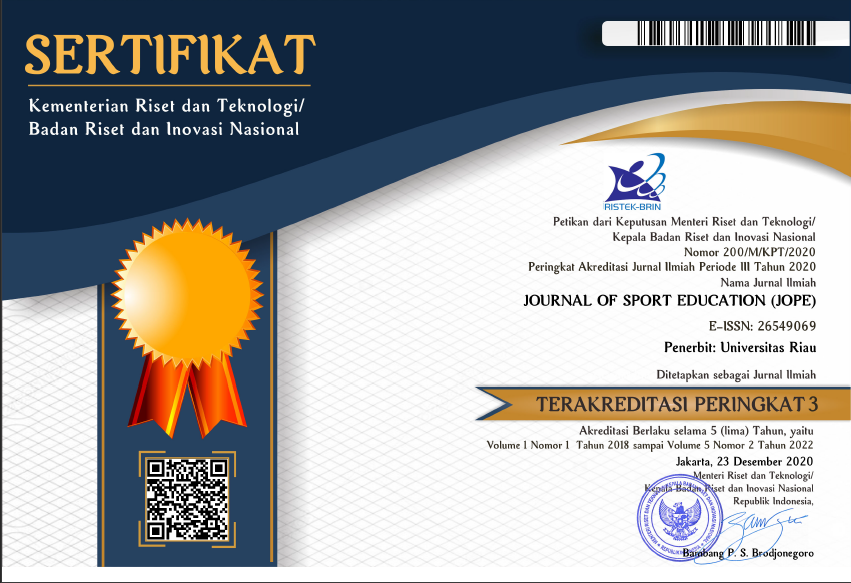Strategi pelibatan mahasiswa dalam pembelajaran daring pada mata kuliah sepak takraw
Abstract
Penelitian tentang pelibatan mahasiswa dalam pembelajaran daring telah banyak dilakukan. Akan tetapi, masih sedikit penelitian yang mengkaji bagaimana dosen melakukan pelibatan mahasiswa pada pembelajaran daring, terutama pada konteks pembelajaran sepak takraw. Untuk mengisi kesenjangan empiris ini, kami melakukan penelitian kualitatif dengan rancangan penelitian studi kasus untuk meneliti bagaimana dosen pengampu mata kuliah sepak takraw melakukan pelibatan mahasiswa pada pembelajaran daring. Partisipan penelitian ini adalah satu orang dosen sepak takraw. Metode pengambilan data dilakukan melalui metode observasi dan wawancara. Instrumen penelitian yang digunakan adalah lembar observasi dan pedoman wawancara. Analisis data dilakukan dengan mengikuti analisis data tematik yang dikemukan oleh Braun and Clarke (2006). Hasil penelitian menunjukkan bahwa dosen sepak takraw menyediakan tiga jenis interaksi: interaksi mahasiswa dengan dosen, interaksi mahasiswa dengan mahasiswa, dan interaksi mahasiswa dengan materi pembelajaran. Ketiga jenis interaksi ini dilakukan untuk menciptakan situasi pembelajaran yang aktif, positif, dan menyenangkan. Dengan demikian, tujuan pembelajaran bisa tercapai dengan baik.
Copyright © The Author (s) 2021

Keywords
Full Text:
PDFReferences
Al Rasyid, M., & Khoirunnisa, F. (2011). The effect of project-based learning on collaboration skills of high school students. Jurnal Pendidikan Sains (JPS), 9(1), 113–119. https://doi.org
16714/jps.9.1.1011.113-119.
Avianty, D., and Anantyarta, P. (2010). Efektifitas online learning terhadap keterlibatan siswa dalam pembelajaran tematik (Matematika & IPA) pada siswa sekolah dasar. Jurnal Pendidikan Matematika Universitas Lampung, 8 (4), 313–14. http://dx.doi.org/10.13960 mtk/v8i1.pp313-314.
Banna, J., Lin, M.G., Stewart, M., and Fialkowski, M. K. (2015). Interaction matters: Strategies to promote engaged learning in an online introductory nutrition course. Journal of Online Learning and Teaching/MERLOT, 11(1), 149-161.
Braun, V., & Clarke, V. (2006). Using thematic analysis in psychology. Qualitative research in psychology, 3(1), 77–101. https://www.tandfonline.com/doi/abs/10.1191/1478088706 qp063oa.
Braun, V., & Clarke, V. (2019). Reflecting on reflexive thematic analysis, Qualitative Research in Sport, Exercise and Health, 11:4, 589-597, DOI: 10.1080/1159676X.1019.1618806.
Byrne, D. (2011). A worked example of Braun and Clarke's approach to reflective thematic analysis. Quality & Quantity. https://doi.org/10.1007/s11135-011-01181-y.
Costley, J., & Lange, C. H. (2017). Video lectures in e-learning: Effects of viewership and media diversity on learning, satisfaction, engagement, interest, and future behavioral intention. Interactive Technology and Smart Education, 14(3), 169-180. https://doi.org/10.1108/ ITSE-08-1016-0015.
Creswell, J. W. (2007). Qualitative inquiry & research design. Choosing among five approaches. Second edition. London: Sage Publications Ltd.
Ceswell, J. W. (2009). Research design. Qualitative, quantitative, and mixed methods approaches. California: Sage Publications Inc.
Dixson, M. D. (2010). Creating effective student engagement in online courses: What do students find engaging? Journal of the Scholarship of Teaching and Learning, 10(1), 1–13. https://www.learntechlib.org/p/54817/.
Dahalan, N., Hassan, H., & Atan, H.(2011). Student engagement in online learning: Learners attitude toward e-mentoring. Procedia-Social and Behavioral Sciences, 67, 464–75. doi:10.1016/J.SBSPRO.1011.11.351.
Double, K. S., Joshua, A. M., & Hopfenbeck, T. N. (2010). The impact of peer assessment on academic performance: A meta-analysis of control group studies. Educational Psychological Review, 31, 481-569. https://doi.org/10.1007/s10648-019-09510-3.
Galikyan, I., & Admiraal, W. (2019). Students’ engagement in asynchronous online discussion: The relationship between cognitive presence, learner prominence, and academic performance. Internet and Higher Education, 43, 1-9.https://doi.org/10.1016/j.iheduc. 1019.100691.
Gunuc, S. (2014). The relationships between student engagement and their academic achievement. International Journal on New Trends in Education and their Implications, 5(4), 199–114. http://www.ijonte.org/FileUpload/ks63107/File/19..gunuc.pdf.
Khan, A., Egbue, O., Palkie, B., & Madden, J. (2017). Active learning: Engaging students to maximize learning in an online course. Electronic Journal of E-Learning, 15(1), 107-115. https://eric.ed.gov/?id=EJ1141876.
Lee, J., & Martin, L. (2017). Investigating students’ perceptions of motivating factors of online class discussions. International Review of Research in Open and Distributed Learning: IRRODL, 18(5), 148–71. https://doi.org/10.19173/irrodl.v18i5.1883.
Mali, Y. C. G. (2016). Project-based learning in Indonesian EFL classroom: From theory to practice. Indonesian Journal of English Education, 3 (1), 89-105. http://dx.doi.org/10.15. 408/ijee.v3i1.1651.
Martin, F., & Bolliger, D. U. (2018). Engagement matters: Student perceptions on the importance of engagement strategies in the online learning environment. Online Learning, 11(1), 105–111. doi:10.14059/olj.v11i1.1091.
Miles, H. M., Huberman,A. M., & Saldana, J. (2014). Qualitative data analysis. A methods sourcebook. 3rd ed. Los Angeles: Sage.
Mulia, N. A. (2010). Indonesian EFL students’ engagement in online language learning platform. RETAIN, 8(1), 154–163.
Pawicara, R., & Conilie, M. (2010). Analisis pembelajaran daring terhadap kejenuhan belajar mahasiswa tadris biologi IAIN Jember di tengah pandemi Covid-19. ALVEOLI: Jurnal Pendidikan Biologi, 1(1), 19–38. https://doi.org/10.35719/alveoli.v1i1.7.
Reyes, M. R., Brackett, M. A., Rivers, S. E., White, M., & Salovey, P. (2011). Classroom emotional climate, student engagement, and academic achievement. Journal of Educational Psychology , 104(3), 1-13. https://eric.ed.gov/?id=EJ993886.
Sholihah, M. (2011). Authentic assesment in online learning during the covid 19 pandemic. Edunesia. Jurnal Ilmiah Pendidikan, 1(1), 576-580. https://doi.org/10.51176/edu.v1i1. 167.
Silverman, D. (2015). Interpreting qualitative data. Los Angeles: Sage Publications, Inc.
Stake, R. E. (1995). The art of case study research. California: Sage Publications, Inc.
Stake, R. E. (2010). Qualitative research: Studying how things work. New York: The Guilford Press.
Stake, R. E. (2005). Qualitative case studies. In N. K. Denzin & Y. S. Lincoln (Eds.), The Sage handbook of qualitative research. Third edition. California: Sage Publications Inc.
Sun, A., & Chen, X. (2016). Online education and its effective practice: A research review. Journal of Information Technology Education, 15, 157-190. https://doi.org/10.18945/ 3501.
Triana, D., Anggraito, Y.U., & Ridlo, S. (2010). Effectiveness environmental change learning tools based on STEM-PjBL towards students’ collaboration and communications skills. Journal of Innovative Science Education, 9(3), 144–149. doi 10.15194/JISE.V8I3.35179.
Wahyudi, W., Budiman, D., & Saepudin, E. (2018). Penerapan model pembelajaran kooperatif tipe TGT dalam pembelajaran permainan bola besar berorientasi sepak takraw untuk meningkatkan kerjasama dan keterampilan bermain. TEGAR: Journal of Teaching Physical Education in Elementary School, 1(1), 1-9. https://doi.org/10.17509/tegar.v1i1. 11731.
Wong, L. (2013). Student engagement with online resources and its impact on learning outcomes. Journal of Information Technology Education: Innovations in Practice, 11, 119–146. https://doi.org/10.18945/1819.
Yang, Y. (2011). Engaging students in an online situated language learning environment. Computer Assisted Language Learning, 14(1), 181–198. https://doi.org/10.1080/09588 111.1010.538700.
Yengin, I., Karahoca,D., Karahoca, A., & Yücel, A. (2010). Roles of teachers in e-learning: How to engage students & how to get free e-learning and the future. Procedia-Social and Behavioral Sciences, 1(1), 5775–5587. https://doi.org/10.1016/j.sbspro.1010.03.941.
Yin, R. K. (2018). Case study research and applications. 8th ed. London: Sage.
Yunitasari, R, & Hanifah, U. (2010). Pengaruh pembelajaran daring terhadap minat belajar siswa pada masa covid 19. Edukatif: Jurnal Ilmu Pendidikan, 1(3), 131–143.https://doi. org/10.31004/edukatif.v1i3.141.
DOI: http://dx.doi.org/10.31258/jope.4.1.40-54
Refbacks
- There are currently no refbacks.











